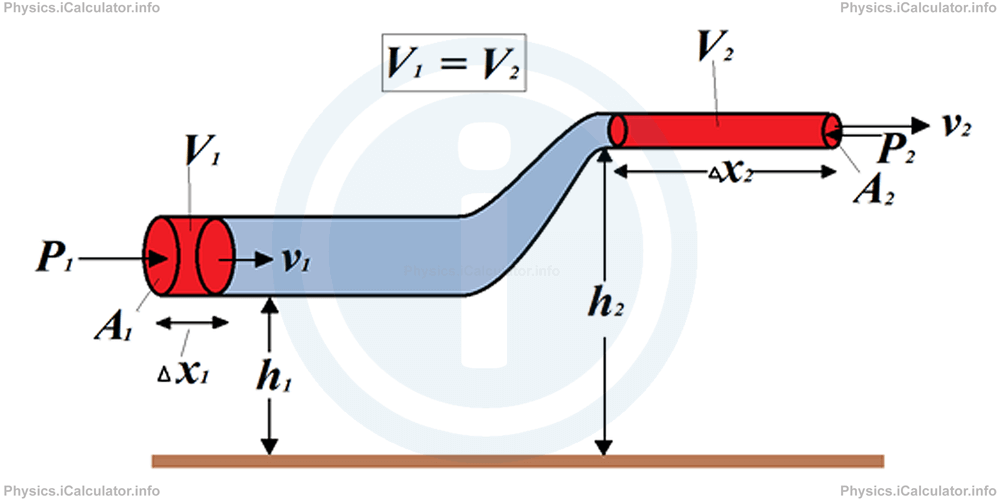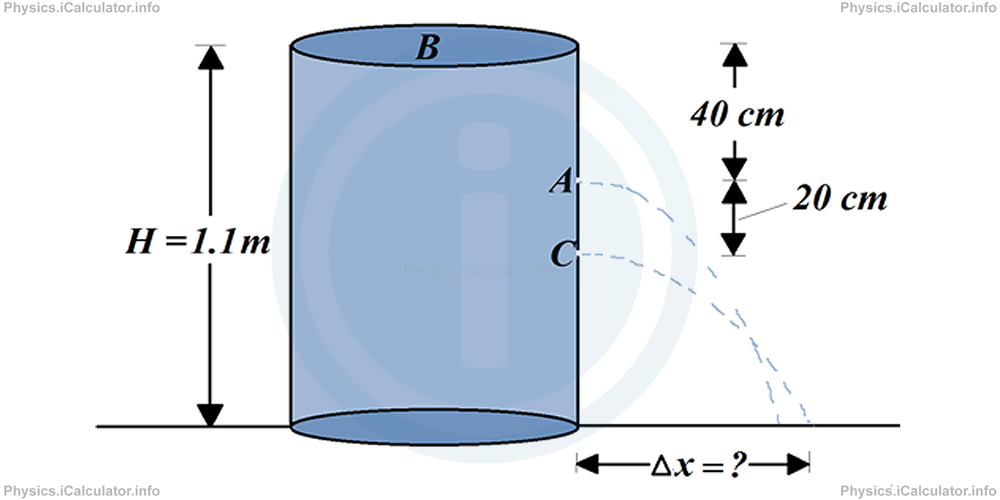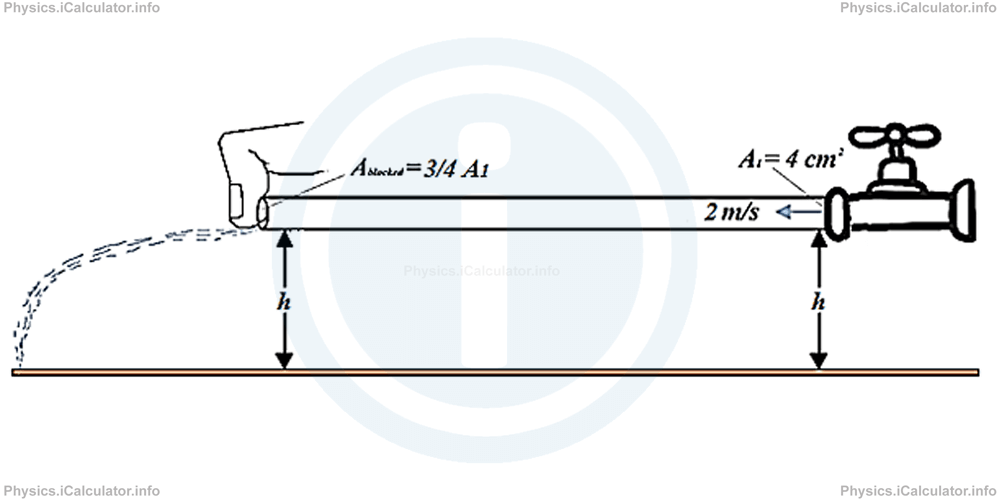Menu
Physics Lesson 9.6.3 - Bernoulli Equation
Please provide a rating, it takes seconds and helps us to keep this resource free for all to use
Welcome to our Physics lesson on Bernoulli Equation, this is the third lesson of our suite of physics lessons covering the topic of Bernoulli Equation, you can find links to the other lessons within this tutorial and access additional physics learning resources below this lesson.
Bernoulli Equation
Consider the situation described in the figure below, in which a liquid is flowing from left to right through a hose with different heights (h1 and h2) and different thicknesses (A1 and A2).

Obviously, we don't expect the liquid have the same flowing speed in both sides, so we write these speeds as v1 and v2 respectively.
Let's consider a water sample of volume V (V1 = V2 = V). It is clear that if we want to send this sample from the left to the right end of the hose, we must use an input force F1 which when multiplied by the input area A1 gives the input pressure P1 (F1 = P1 × A1), otherwise, the liquid will not raise on the right part, because of the gravity. However, since the right end of the hose is open and therefore it is in contact with air, we have an opposing force F2 caused by the atmospheric pressure P2 on the output area A2 (F2 = P2 × A2).
Both the above forces do some work on the liquid. Thus, the source does the work W1 = F1 × Δx1 on the liquid, while atmosphere does the work W2 = F2 × Δx2 on the liquid. Since the input work is positive and the output work is negative, we obtain for the resultant work done on the system
= F1 × ∆x1 - F2 × ∆x2
This change in work contributes in the change of the mechanical energy ME of the system. Thus, since mechanical energy is the sum of kinetic and gravitational potential energy, we can write
= ∆KE + ∆GPE
Given that KE = m × v2 / 2 and GPE = m × g × h, we obtain
∆W = KE2-KE1 + GPE2-GPE1
F1 × ∆x1-F2 × ∆x2
= m × v22/2 - m × v12/2 + m × g × h2 - m × g × h1
Substituting forces F1 and F2 by P1 × A1 and P2 × A2 respectively, and also expressing mass as a product of density and volume (m = ρ × V), we obtain
= ρ × V × v22/2 - ρ × V × v12/2 + ρ × V × g × h2-ρ × V × g × h1
Also, since there is the same liquid in both sections considered, we have the same volume as stated earlier, i.e. V1 = V2 = V = A1 × Δx1 = A2 × Δx2.
Thus, we can write
= ρ × V × v22/2 - ρ × V × v12/2 + ρ × V × g × h2 - ρ × V × g × h1
Simplifying volume V from both sides, we obtain
= ρ × v22/2 - ρ × v12/2 + ρ × g × h2 - ρ × g × h1
Rearranging the terms of the above equation, we obtain
= P2 + ρ × v22/2 + ρ × g × h2
The above formula gives the Bernoulli Equation for a fluid in two states, 1 and 2. It is named after the Swiss scientists Daniel Bernoulli, who analysed the flowing properties in fluids during the 18th century. Generalizing this equation for all possible states, we obtain
Example 2
A cylinder completely filled with water is 1.1 m high. If we open a small hole in the lateral side of cylinder (at point A), 40 cm below the water surface, calculate:
- The emerging speed of water from the hole (vA = ?)
- If we open another identical hole at 20 cm below the first one (at point C), how far from the lower base will the water emerging from the second hole be, when it falls on the ground? (Δx = ?)

Take the upper surface of water as still. Also, take g = 10 m/s2 and ρwater = 1000 kg/m3.
Solution 2
a Let's try to cancel out some of the terms from the Bernoulli equation
= P2 + ρ × v22/2 + ρ × g × h2
This can be achieved by trying to choose an appropriate point of reference for the initial state. Thus, if we choose the point B at the water surface as a reference point, we write the index B instead of 1 and A instead of 2. In this case, we can cancel PB and PA from both sides of Bernoulli equation as both point are under the influence of atmospheric pressure Patm (both of them are in contact with the atmosphere). Thus, the Bernoulli equation becomes
= ρ × v2A/2 + ρ × g × ha
Since we have chosen the point B as a reference, we have hB = 0 and hA = - 40 cm = - 0.40 m. Also, we can cancel out the water density ρ from both sides of equation. Finally, we have vB = 0 as water in the upper surface is still. Hence, we obtain
v2A = -2 × g × ha
va = r = √-2 × g × ha
= r = √-2 × 10 × (-0.40)
= r = √8.00
= 2.83 m/s
b The same reasoning (and procedure) can be used to find the emerging speed of water from the point C. Then, since water trajectory is parabolic, we can use the equations of projectile motion to determine the horizontal displacement Δx.
This time, the Bernoulli equation is
= ρ × v2C/2 + ρ × g × hc
Thus, choosing now the position A as reference point, we obtain hA = 0 and hC = - 20 cm = - 0.20 m. Also, we cancel out again the density of water ρ and pressures PA and PC as both points are in contact with the atmosphere, i.e. PA = PC = Patm. Thus, the Bernoulli equations for this situation becomes
Hence,
Multiplying both sides by 2, we obtain
vc = √v2A - 2 × g × hc
= √2.832 - 2 × 10 × (-0.20)
= √8 + 4
= √12
= 3.46 m/s
Given that the height of the point C from the ground is hC = 1.1 m - 0.4 m - 0.2 m = 0.5 m, we can determine the falling time t using the kinematic equation
as in the vertical direction, we consider water as falling freely. Thus,
= √2 × hc/g
= √2 × 0.5/10
= √0.1
= 0.32 s
Therefore, the horizontal distance from the cylinder lower base in which the water coming out from the point C falls on the ground is
= 3.46 m/s × 0.32 s
= 1.11 m
Thus, water coming out from the point C falls 1.11 m on the right of the cylinder.
The Simplified Version of Bernoulli Equation
In situations involving the Bernoulli Equation
= P2 + ρ × v22/2 + ρ × g × h2
the terms ρ × g × h1 and ρ × g × h2 are often cancelled out because the changes in flowing height are small, i.e. h1 ≈ h2. Therefore, we obtain a simplified version of Bernoulli equation:
= P2 + ρ × v22/2
It is obvious that the terms ρ × v21/2 and ρ × v22/2 represent pressure as we cannot add two quantities that are not of the same type. More precisely, they represent the dynamic pressure as they involve the flowing speed of liquid v. On the other hand, the terms P1 and P2 represent the static pressure we have discussed earlier. Therefore, we can obtain a simplified version of Bernoulli equation, which states that:
This statement is similar to the definition of mechanical energy we have discussed in Section 5 (ME = KE + PE = constant).
Special Cases of Bernoulli Equation Applications
Not all terms of the Bernoulli Equation
= P2 + ρ × v22/2 + ρ × g × h2
are always present in a given situation. Thus, for example, in static liquids (when liquids are not flowing), the terms related to flowing velocities are not considered. Therefore, the Bernoulli Equation becomes
Furthermore, if we take the reference point at one of the given positions (for example at the position 1, the term related to the height h1 is cancelled out as h1 = 0. Therefore, the Bernoulli Equation is further simplified and becomes
On the other hand, when height difference is negligible as discussed in the previous section, the height-related terms cancels out from Bernoulli Equation, so it becomes
= P2 + ρ × v22/2
Finally, if there is the same pressure in both parts examined (for example, if both positions are in contact with the atmosphere as in the previous example, the static pressure-related terms P1 and P2 cancel out from the Bernoulli equation, and we therefore obtain
= ρ × v22/2 + ρ × g × h2
Since in most cases there is the same liquid flowing throughout the tube, the density cancels out. Also, if we take one of the positions as a reference point (for example the position 1, so h1 = 0), the Bernoulli Equation becomes
Example 3
If the pushing force of the tap in the figure below is 12 N and the hose is 4 cm2 thick, what is the water speed at the output if we block three quarters of the hose's end by placing the thumb on it? Water comes out from the tap at 2 m/s and the entire hose is in the horizontal position. Take g = 10 m/s2 and ρwater = 1000 kg/m3. Also take the atmospheric pressure Patm = 100 000 Pa.

Solution 3
Let's convert the input and output areas into m2 first. Thus, A1 = 4 cm2 = 0.0004 m2 and A2 = A1 - 3/4 A1 = 1/4 A1 = 1/4 × 4 cm2 = 1 cm2 = 0.0001 m2.
Since there is the same height in both ends of the hose, the height-related term in the Bernoulli Equation
cancel out. Thus, we have
The input pressure is obtained by the equation
= 12 N/0.0004 m2 + 100 000 Pa
= 30 000 Pa + 100 000 Pa
= 130 000 Pa
(Here we must consider the total pressure as input, not only water pressure, because water is in contact with the atmosphere at the source. If it were not so, water would turn back to the source when we close the tap due to the pushing force exerted by the atmosphere at the output.)
Now let's substitute the values in the (reduced) Bernoulli Equation. Thus,
130 000 + 2000 = 500 × v22 + 100 000
32 000 = 500 × v22
v22 = 32000/500 = 64
v2 = √64
= 8 m/s
You have reached the end of Physics lesson 9.6.3 Bernoulli Equation. There are 3 lessons in this physics tutorial covering Bernoulli Equation, you can access all the lessons from this tutorial below.
More Bernoulli Equation Lessons and Learning Resources
Whats next?
Enjoy the "Bernoulli Equation" physics lesson? People who liked the "Bernoulli Equation lesson found the following resources useful:
- Practical Feedback. Helps other - Leave a rating for this practical (see below)
- Density and Pressure Physics tutorial: Bernoulli Equation. Read the Bernoulli Equation physics tutorial and build your physics knowledge of Density and Pressure
- Density and Pressure Revision Notes: Bernoulli Equation. Print the notes so you can revise the key points covered in the physics tutorial for Bernoulli Equation
- Density and Pressure Practice Questions: Bernoulli Equation. Test and improve your knowledge of Bernoulli Equation with example questins and answers
- Check your calculations for Density and Pressure questions with our excellent Density and Pressure calculators which contain full equations and calculations clearly displayed line by line. See the Density and Pressure Calculators by iCalculator™ below.
- Continuing learning density and pressure - read our next physics tutorial: Adhesive and Cohesive Forces. Surface Tension and Capillarity
Help others Learning Physics just like you
Please provide a rating, it takes seconds and helps us to keep this resource free for all to use
We hope you found this Physics lesson "Bernoulli Equation" useful. If you did it would be great if you could spare the time to rate this physics lesson (simply click on the number of stars that match your assessment of this physics learning aide) and/or share on social media, this helps us identify popular tutorials and calculators and expand our free learning resources to support our users around the world have free access to expand their knowledge of physics and other disciplines.